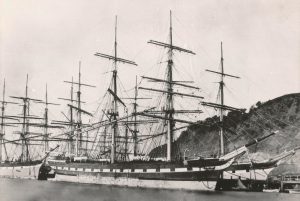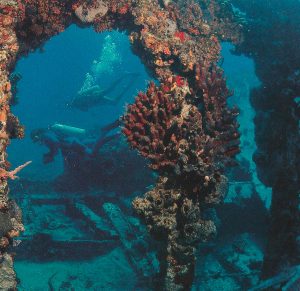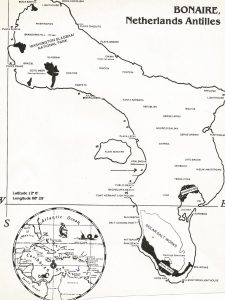Bonaire Windjammer is Ghostly Encounter

The Windjammer Mairi Bhan at Dockside
I don’t know who named the Mairi Bhan a “ghost ship.” Perhaps it was the local fishermen, but the moniker has stuck throughout the years. Divers refer to the 239-foot- square-rigged bark as the “Windjammer.” A deep encounter for experienced divers, the three-masted merchant vessel, victim of a storm in 1912, rests on her starboard side close to shore off the port city of Kralendijk, Bonaire, in the Lesser Antilles. A boat or shore dive, the wreck lies in 140 to 180 feet of water directly in front of the Bonaire Petroleum Corporation (BOPEK) fuel oil storage and transportation terminal.

Marine Life Abounds on the Mairi Bhan
Divers lose some of the bright light in the crystal clear waters as they drop to within 100 feet of the remains. That’s when a large, dark silhouette appears suddenly, its size enhanced by the white, sandy bottom. The vessel looked like a Hollywood movie set to me when I visited it a few years ago. The iron hull was still well preserved with its railings intact. Divers may remain near the railings at 140 feet or descend another 40 feet and peer into the dark, hollow innards of the hull. Teredo worms ate the wooden decks away and the remaining metal fittings were salvaged. There were no engines…it was the age of sail. Two of the masts, one with a crow’s nest attached, rest on the bottom slanting down and away in deeper water. Bright colored hard and soft corals, flanked by crinoids and nudibranchs, cling to the hull. Margates and groupers dart around the coral formations, then slip into the shelter of the shadows. Fragments of asphalt litter the bottom, part of the cargo that spilled out when the ship keeled over.
The Mairi Bhan (Gaelic for Bonny Mary) is listed in Lloyd’s Wreck Returns for the year 1912, “sunk off the coast of Bonaire while transporting a load of asphalt from Trinidad to Marseille, France.” Built in 1874 at Glasgow, Scotland, the 1,315-ton vessel was built to ship hand-crafted goods from New Delhi, India to London, England, for a thriving import business. Contemporary accounts called her “one of the handsomest ships sailing the Pacific.” Her maiden run from Glasgow to Port Chalmers, New Zealand, was completed in 75 days, very fast back then. She was sold at the turn of the century to an Italian firm, Denegri and Mortola, based in Genoa.

Bonaire, Netherlands Antilles
The Italians turned her into a tramp sailer that went wherever the business was good. In 1912, she carried leather goods, fabrics, olive oil and marble from Italy to Trinidad where she traded for a load of asphalt and headed for Marseille. While riding the trade winds off Venezuela, she made a northeast turn to cross the Caribbean when a sudden storm roared out of the mountains. Capt. Luigi Razeto, ship’s master for five years, decided to head for the protection of Bonaire, but got blown past the island in a northward surge. As he doubled back along the coast, his vessel grounded on the reef and began to list. Barrels of asphalt shifted and broke open in the holds releasing fumes which were ignited by a kerosene lamp. During the ensuing explosion and raging fires, four crewmen were swept away and perished, while 28 others made it safely to shore. With her bow facing the shore, the windjammer heeled to starboard, slid down the reef and ended up at the bottom of the drop-off. The molten asphalt spilled out of the holds like lava and hardened on the bottom to form a flat black plain as the ship settled in unseen by anyone until more than half a century later.
When Spanish explorer Amerigo Vespucci landed in Bonaire in 1499, he found a tribe of Arawak Indians chewing divi-divi leaves for moisture while awaiting the rainy season. Fascinated by their culture and the 24 by 7 mile island with its many goats and iguanas, he vowed to return. Today, divers who visit the island take the same vow, only in this instance Bonaire returns on its own. Shaped like a boomerang, it keeps coming back in dreams of white sand beaches, friendly people and a fascinating ghost ship sunk in crystal clear seas.
8 Comments
Submit a Comment
All Rights Reserved © | National Underwater and Marine Agency
All Rights Reserved © | National Underwater and Marine Agency
Web Design by Floyd Dog Design
Web Design by Floyd Dog Design

I liked your article about the Blonaire windjammer. How experienced should a diver be in order to make this dive? Thank you .
Thank you, I’m glad you liked the article about the windjammer. I can’t give you a number, relating to your number of dives made and what the depths might have been. If you’ve completed a successful dive to 100 feet or more, I think you might be able to see the windjammer at 140 feet. That would be with a guide and it would be swimming over the wreck, not going to the 180 foot depth where it rests. I suggest you go to Capt. Don’s Habitat and ask for Janet. I think she is still there. I know her from some years back. She is very helpful. She, in turn, will pick out an experienced guide to take you to the site. Both Janet and the guide could also help you define your experience level. I hope this has been helpful to you. Let me know if you go. Best regards, Ellsworth
Hello Professor,
I have read several of your articles and was wondering, what are some good books that you would recommend for learning about marine archeology?
Evan: The main book I always turn to for research is: “Shipwrecks and Archaeology: The Unharvested Sea” by Peter Throckmorton. You can get it for seven or eight dollars on ebay. Actually, any books on this subject by Peter Throckmorton are usually good ones. He was very knowledgeable and wrote many books and articles on the subject. He died in 1990 and was ranked highly among marine archaeologists.
I’m currently vacationing in Bonaire after a hiatus of more than 15 years. I dove the Marie Bhan just after a hurricane blew through the island and what I think I remember was being able to see the smooth hull exposed and these long lines down the hull, like carvel-hall wood planking, but when I knocked on it, it felt as hard as iron. You could also see the asphalt spilled out onto the sand. I was on another website trying to show my children what their parents had done many years ago and….well, the pictures looked very different from what I remember. As I moved towards the stern at 190 feet…I was getting pretty narced….but I swore I saw a prop.
Perhaps my memories lie…
But I don’t think so.
I also recall a crazy dutchman who put his flippers on his head…..made him look like Bugs Bunny.
Those were some good times…..
These are fond memories. I visited this site too. It was quite a thrill. The history of the wreck is interesting.
In 2003 I was enjoying a dive vacation in Bonaire. My dive buddy and I were fascinated by the tee shirts we saw in the resort’s dive shop with pictures of the Windjammer. We wanted to dive this spectacular wreck, but it was not listed on the map of dive spots we were given by the dive master and no one in the shop or anyone in other local dive shops would divulge its location. They said several divers had died while diving that wreck and no one was allowed to drive it anymore. As we were leaving one shop after another fruitless inquiry, another patron followed us from the store and called to us to hold on. He turned out to be a local, old salt and expatriate who claimed he knew where to find the Windjammer and for $50 each would guide us to the wreck. We accepted his offer. We walked into the water with him and surface swam about 100 yards out. He said we were looking for a crossed mast on the bottom, encrusted wth coral and sponges. I kept my eyes on the bottom and soon spotted mast. X marks the spot. He told us to point our heads straight down and kick hard for the bottom. We slipped over a ledge heading into a murky nothingness. After kicking hard for a couple minutes, the iron hull of the ship began to appear below us and suddenly, the the water became crystal clear and visibility opened up to over 100 feet. We could see the entire ship. Absolutely awesome! Our guide told us in advance we would only have 8 minutes of bottom time, so we started exploring immediately. We had dropped down about midship, so we turned toward the bow an swam along the edge of the rail, looking down into the gutted bowels of the old Windjammer while frequently reacting out to touch the encrusted iron hull as we made our way to the bowsprit. Once arrived at the tip of the ship I placed my dive computer on the sandy bottom where it registered 197 feet (although I tell people it was an even 200). And then it was time to start up. Once up over the top of the wall of the canyon the wreck lies in, we slowly swam along the bottom to our entry point on shore. The very gradual rise in the bottom we followed over the next15 or 20 minutes acted as our decompression. We arrived on shore healthy, happy, and savoring one of the most memorable experiences of our lives.
Andrew: This was a very nice experience. Thanks for sharing it. Yes, the Windjammer is not difficult to find if you get the correct directions. And it’s an easy shore dive being so close to land.
You can see why the local divers don’t want many people diving on it. Proper decompression is a must. Inexperienced divers could mess up easily. Not many divers dive it. You and your dive buddy experienced an exceptionally good deep dive. It was money well spent!